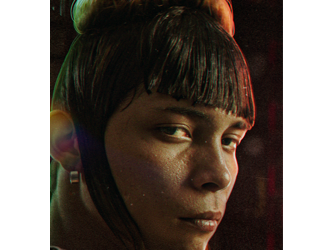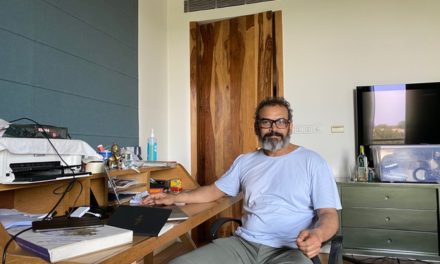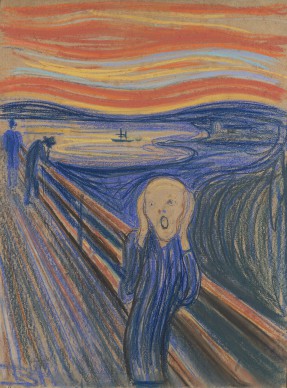Celebrations

Pablo Picasso
The museums of the world are vibrating in unison to the tune of Pablo Picasso. Sprawling celebrations are being staged to mark fifty years since the Spanish master’s death. In New York alone the art star is, between now and September 2023, the subject of exhibitions at the Guggenheim Museum, the Metropolitan Museum and at Moma. Every gesture, every artistic practice, every subject of inspiration of the master and virtually every day of his artistic output, are being placed under the microscope by institutions across the planet. As the thrilling “Picasso et la préhistoire” exhibition at the Musée de l’Homme in Paris comes to a close, the Picasso Museum in Barcelona will be looking at his rapport with another Spanish giant, Miro. Then there’s his relationship with religion at the Thyssen-Bornemisza in Madrid, or in Bucharest with the impact on local artists made by one of his exhibitions in 1968 in Romania (See here and here the last reports about some Picasso shows).
Powerful discordant note
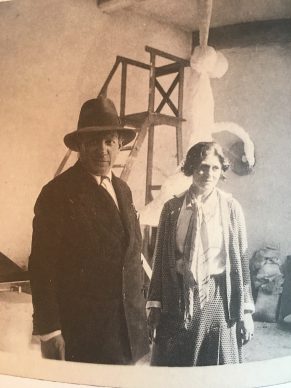
Picasso and Olga
Amid the unanimity of this institutional ode to the glory of the Malaga native, a powerful discordant note is resonating on the outskirts of Manhattan, made by a museum – and one that is no less serious.
On 2 June 2023 an exhibition is opening at the Brooklyn Museum in New York as part of the celebrations, overseen by the Musée Picasso in Paris, which is loaning several of their paintings. Its title, however, does not take the form of praise: “It’s Pablo-matic: Picasso according to Hannah Gadsby”.
Pablo-Matic
“Pablo-matic” is clearly a play on words associating Picasso with being problematic. While Hannah Gadsby is an Australian comedian who specializes in stand-up, whose show “Nanette”, described as “revolutionary” by the Brooklyn Museum’s press release, is available to watch on Netflix. Nanette is the name of a waitress who failed to succumb to the charms of Hannah Gadsby. The show is a collage of her thoughts about daily life that also features her experience of cubism, from when she was studying art history at the age of 17. On this occasion she declares: “I hate Picasso, I hate him. And you can’t make me like him.”
She hates him
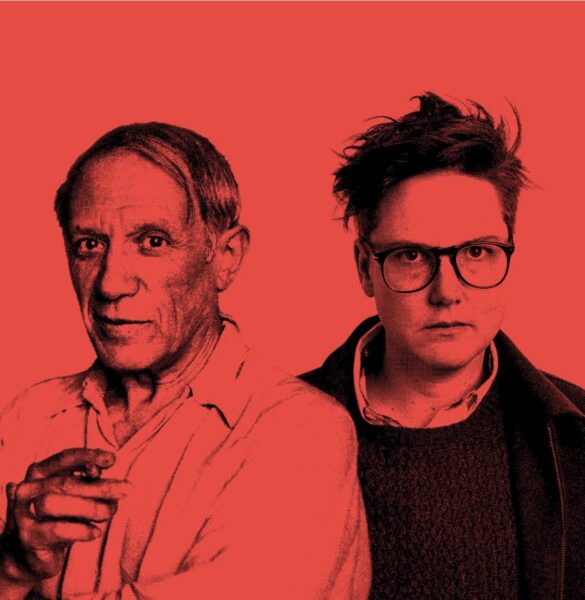
Pablo-Matic
I asked the museum’s director, Anne Pasternak, about this astonishing choice of a curator who claims to hate the artist who is subject of the exhibition. She answers via email: “If you are asking why we included Hannah in the curatorial team, then I’ll share this: we are a 21st-century museum that grapples with history and contemporary thought, so we wanted to offer something additive to the myriad of Picasso exhibitions around the globe. Our show therefore looks at the 50 years since Picasso’s death in 1973, a time during the Feminist Movement and a moment when more women artists started to enter into the art field and have grappled with Picasso’s profound legacy. Over the decades since his passing, Picasso’s alleged behavior has cast a shadow over the art for many people. Many are grappling with the question of can we separate the artist from the art.”
Sensationalist title
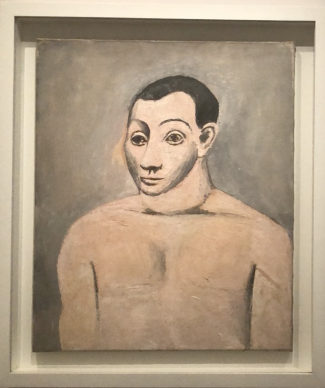
Pablo Picasso
Furthermore, she points out that Hannah Gadsby is accompanied by two curators from the museum. While the exhibition is looking at Picasso’s oeuvre together with that of women artists of various styles, such as Louise Bourgeois and the Guerilla Girls, through the sensationalist title she is exclusively pushing what she condemns to the fore.
More generally, “Pablo-matic” echoes a tidal wave that was born around two years ago on social media, under the explicit influence of the #MeToo movement. The burning issue at stake was the misogyny of the artist, who is now presented as a veritable Bluebeard.
Bernard Picasso
Bernard Picasso, the grandson of Olga and Pablo Picasso, co-founder of the Picasso Museum in Malaga and curator of the exhibition “Picasso: Untitled” at the Casa Encendida in Madrid until January 2024, has an interesting position on the subject of “Pablo-matic”: “I really like the title they’ve given to the exhibition at the Brooklyn Museum, ‘Pablo-matic’. I took part in the project, and I particularly respect this institution. Art is a living thing that allows for experimentation. Artists give us the possibility of looking at things differently. I don’t think that it is unfair. The subject is to talk about the heritage of the 20th century on different levels, Picasso being one of the major artists of that era. Other artists are going to comment on his work or his life. Hannah Gadsby is an unconventional figure. We live in a system where we are lucky enough to benefit from freedom of expression.”
Simplistic vision of the genius
Cécile Godefroy, the head researcher at the new Picasso Studies Centre at the eponymous Parisian museum, is one of the researchers who is best authorized on a global level to comment on the facts: “We must get out of the simplistic vision of the genius surrounded by his muses,” she adds, overseeing the mega-project of the artist’s digital portal that will be making available online from the end of 2023 over 200,000 pieces from his life and work. “The opening of the studies centre will enable people to get the source of the information.” For herein lies the problem. Since Picasso sells, Picasso also attracts various talents.
Far from irreproachable
However, it is important to highlight that in his private life Picasso was far from irreproachable. This was clearly the case with women, but also more generally with others surrounding him. Towards the end of his life, most likely encouraged by his last partner, Jacqueline, he stopped seeing his children Claude and Paloma after the publication by their mother of a book in 1965, “Life with Picasso” (see the interview with Paloma Picasso at the end of this article). They weren’t even invited to the painter’s burial. “In his daily life his habitual way of relating was one of domination,” observes Cécile Godefroy.
Jean Cocteau a courtier
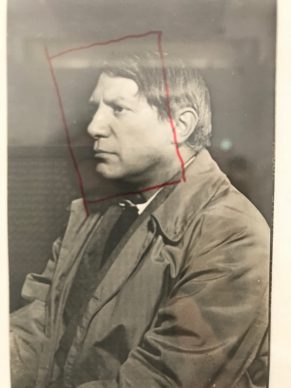
Pablo Picasso
“Jean Cocteau was placed in a role of a courtier. The painter would frequently fail to respond to his great dealer Kahnweiler. Picasso is also accused of not having defended Max Jacob, who died at the Drancy internment camp. But it so happened that this argument was dismantled by the historian and specialist on the poet, Hélène Seckel.”
Caricature
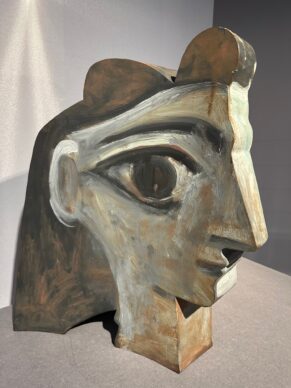
Pablo Picasso
“The problem with Picasso and women is put to me constantly,” observes the director of the Picasso Museum in Barcelona, Emmanuel Guigon. “It’s clear that he was a chauvinist, and the way he thought was perfectly in line with his times. The only thing that interested him was his work: painting, sculpting and, from 1936, writing too. But since his biographers have punctuated his periods of creation according to the women he was seeing, things have been relatively caricatured.”
Faith Ringgold
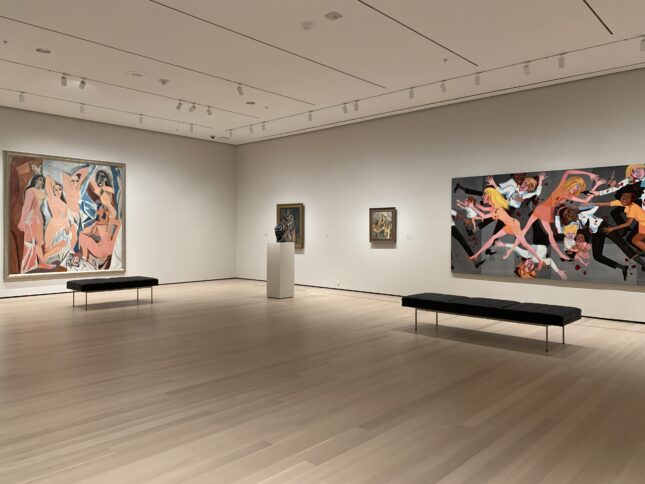
Pablo Picasso, Faith Ringgold, Moma NY
Cécile Debray, who has been well aware of the issue since she was appointed head of the Picasso Museum in 2021, has put in place an entire programme of exhibitions by women artists at the institution, such as the exhibition staged until 2 July featuring the very talented African American feminist Faith Ringgold. For one of her most famous works, “American People,” from 1967, she was explicitly inspired by the Malaga master’s Guernica (See here the report about the Faith Ringgold exhibition). Cécile Debray shares the opinion of her counterpart in Barcelona: “Picasso was born in Andalusia in 1881. He comes from a patriarchal culture. He was a seducer, very jealous, and clearly in a position of domination in relation to women. His biographies have been written by specialists who were fascinated by him, such as John Richardson or Pierre Daix. They were true guardians of the temple. His body of work should now be seen in a new way, as certain historians have started to do, such as Marie-Laure Bernadac.”
Sexuality in art
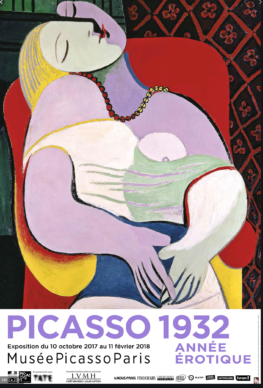
Picasso 1932
The latter, who has served as a curator in the creation of the Picasso Museum in Paris in 1985, participated on 13 February 2023 in a monthly conference organized by the institution, which seeks to revisit the great Picasso myths. This time the theme was: “Sexuality in art”. She explains: “This new Picasso bashing is primarily the result of an overexposure of the artist. There are too many Picasso exhibitions. And then people confuse the phantasmic images he produces in his oeuvre with his personal life. Art history is fuelled by passions, destructions, tragedies.
Dora Maar, Mater Dolorosa

Picasso in front of a Dora Maar head
His ‘Crying Woman’, for example, Dora Maar, is a Mater Dolorosa in the great iconographic Catholic tradition. We cannot reduce it to a simple victim of domestic violence. Moreover, this was during wartime and she lost her mother in 1940… Today we are cruelly lacking in-depth analyses of Picasso’s oeuvre. The prevailing discourse gives a poor image of the feminist fight.
Miriam Cahn
What would we say about de Sade or Georges Bataille in that case? Should we erase them from the cultural landscape too?” Marie-Laure Bernadac also reveals how, during the conference, when the other guest, Miriam Cahn, the Swiss painter that cannot be suspected of not defending women (1) was asked about this she said: “When I was a little girl I didn’t hate Picasso. I wanted to be Picasso.”
Misunderstanding
The biggest misunderstanding with Picasso relates to the fact that a man capable of paving the way in an exceptional manner for the avant-garde in painting in the 20th century should be, in his private life, a typical 19th-century figure.
1) She was the subject until 14 May of an exhibition at the Palais de Tokyo that caused controversy due to the raw nature of certain canvases addressing current issues, in particular with regards to the far right, which gave rise to the defacing of a work whose title is “Fuck Abstraction”.
Paloma Picasso is the daughter of Françoise Gilot and Pablo Picasso
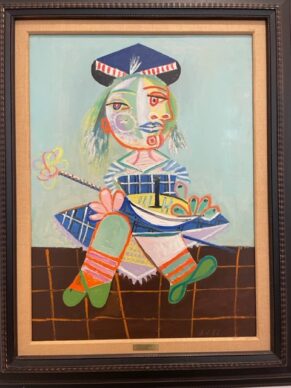
Pablo Picasso
What do you think of the wave of “Picasso bashing” that is currently taking place?
The figure of Picasso is being used as part of a propaganda campaign orchestrated against masculinity. Of course we all know there was the story with Marie Thérèse when she was 17 years old. During his life he generally had relationships with women who were younger than him, but I suppose this was for aesthetic reasons. He also had friends who were women, as well as women with whom he worked, such as Marie Cuttoli – who made tapestries with him – or Madame Ramier, with whom he created ceramics. These are the things that aren’t talked about. Of course sexuality plays an important role in his inspiration, but that doesn’t mean he saw women only ‘through the eyes of Eros’.
So when my mother left him he made a major series of portraits of a very young woman called Sylvette whom he met in Vallauris. She said in an article that appeared in an English publication, a few years ago, that he was always very respectful, without any questionable gestures. A friend sent me the article and I asked why. Now I understand it was very good that this interview took place. But we also cannot look at the past through the eyes of the present day. He was born in 1881 in a context where machismo was omnipresent.
You saw your father regularly up until the age of 15
Until I was 15 years old I spent all my holidays with him, which was two or three months a year. When I was a young girl, I was perhaps treated even better than my brother. It must be said that I was a very good child, I could sit still and do my own drawings for three hours, so he would let me stay with him while he painted. I never had the impression that he treated women differently. But it’s true that I saw him through my eyes, his daughter’s eyes.
Although after a certain point he refused to see you
I didn’t see him during the final ten years of his life. It’s a complicated subject that has more to do with the attitude of my stepmother, Jacqueline. She did the same thing to Maya (ed. the daughter Picasso had with Marie-Thérèse Walter). When we became teenagers she thought perhaps we would judge her, and distance her too. So she used the pretext that my mother wrote the book, “Life with Picasso”, to say that we were on my mother’s side. I never felt like I had a problem with my father. When I had the occasion to meet him later I didn’t say, ‘do you know that I came, I rang the bell and I was told you weren’t there?’ and I regret it. I never felt he no longer loved me.
Donating=Supporting

Support independent news on art.
Your contribution : Make a monthly commitment to support JB Reports or a one off contribution as and when you feel like it. Choose the option that suits you best.
Need to cancel a recurring donation? Please go here.
The donation is considered to be a subscription for a fee set by the donor and for a duration also set by the donor.

